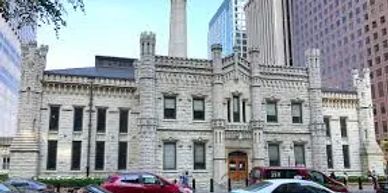WhereChicago — Chicago’s Premier Travel & Lifestyle Guide
Exploring the Stories Behind Chicago Landmarks
The Chicago Water Tower & Pumping Station
The Chicago Water Tower & Pumping Station
The Chicago Water Tower & Pumping Station

One of the few buildings to survive the Great Chicago Fire, the Chicago Water Tower is more than just a beautiful piece of Gothic Revival architecture — it’s a symbol of the city’s rebirth. Built in 1869 from yellow Joliet limestone, it’s now surrounded by modern skyscrapers, creating a stunning contrast between old and new.
📸 Don’t miss: The City Gallery inside, featuring rotating art exhibits by local photographers.
Location: 806 N. Michigan Ave.
The Rookery Building
The Chicago Water Tower & Pumping Station
The Chicago Water Tower & Pumping Station

Designed by Burnham & Root in 1888 and remodeled by Frank Lloyd Wright, the Rookery Building is an architectural masterpiece blending classic and modern design. Its intricate ironwork and sunlit central atrium make it a must-see for anyone interested in Chicago’s role in architectural history.
💡 Fun Fact: The Rookery housed early offices for architects Daniel Burnham and John Root, who helped design the 1893 World’s Columbian Exposition.
Location: 209 S. LaSalle St.
The Chicago Theatre
The Chicago Water Tower & Pumping Station
The Chicago Theatre

With its famous red CHICAGO marquee, the Chicago Theatre is one of the city’s most photographed landmarks — and for good reason. Opened in 1921, it was the first large, lavish movie palace in the U.S. and set the standard for theaters nationwide.
Today: It hosts concerts, comedy shows, and film festivals, continuing its legacy as a cultural icon.
Location: 175 N. State St.
⚾ Wrigley Field
🌉 The DuSable Bridge (Michigan Avenue Bridge)
The Chicago Theatre

Home of the Chicago Cubs since 1916, Wrigley Field is a shrine for baseball fans and a beloved part of the city’s identity. The ivy-covered outfield walls, manual scoreboard, and vintage charm make it a true time capsule of America’s pastime.
🥇 Insider Tip: Even if it’s not game day, you can book a Wrigley Field Tour to explore the dugout, press box, and legendary bleachers.
Location: 1060 W. Addison St.
🏠 Frank Lloyd Wright’s Robie House
🌉 The DuSable Bridge (Michigan Avenue Bridge)
🌉 The DuSable Bridge (Michigan Avenue Bridge)

A UNESCO World Heritage Site, the Robie House in Hyde Park is one of Frank Lloyd Wright’s most famous designs — and a defining example of the Prairie School architectural style. Its low horizontal lines and open layout were revolutionary for early 20th-century design.
🎨 Don’t Miss: A guided tour of the interior for a deeper look into Wright’s vision of modern living.
Location: 5757 S. Woodlawn Ave.
🌉 The DuSable Bridge (Michigan Avenue Bridge)
🌉 The DuSable Bridge (Michigan Avenue Bridge)
🌉 The DuSable Bridge (Michigan Avenue Bridge)

Named after Jean Baptiste Point du Sable, Chicago’s first non-Indigenous settler, the DuSable Bridge connects the city’s north and south sides and marks the birthplace of Chicago. Completed in 1920, it’s not only a key piece of infrastructure but also an open-air museum of the city’s history.
💡 Fun Stop: Visit the McCormick Bridgehouse & Chicago River Museum inside one of the bridge’s towers.
Location: Michigan Ave. over the Chicago River
Willis Tower (F.K.A Sears Tower)
Willis Tower (F.K.A Sears Tower)
Willis Tower (F.K.A Sears Tower)

Named after Jean Baptiste Point du Sable, Chicago’s first non-Indigenous settler, the DuSable Bridge connects the city’s north and south sides and marks the birthplace of Chicago. Completed in 1920, it’s not only a key piece of infrastructure but also an open-air museum of the city’s history.
💡 Fun Stop: Visit the McCormick Bridgehouse & Chicago River Museum inside one of the bridge’s towers.
Location: Michigan Ave. over the Chicago River
Wrigley Building
Willis Tower (F.K.A Sears Tower)
Willis Tower (F.K.A Sears Tower)

Named after Jean Baptiste Point du Sable, Chicago’s first non-Indigenous settler, the DuSable Bridge connects the city’s north and south sides and marks the birthplace of Chicago. Completed in 1920, it’s not only a key piece of infrastructure but also an open-air museum of the city’s history.
💡 Fun Stop: Visit the McCormick Bridgehouse & Chicago River Museum inside one of the bridge’s towers.
Location: Michigan Ave. over the Chicago River
Tribune Tower
Willis Tower (F.K.A Sears Tower)
Tribune Tower

Named after Jean Baptiste Point du Sable, Chicago’s first non-Indigenous settler, the DuSable Bridge connects the city’s north and south sides and marks the birthplace of Chicago. Completed in 1920, it’s not only a key piece of infrastructure but also an open-air museum of the city’s history.
💡 Fun Stop: Visit the McCormick Bridgehouse & Chicago River Museum inside one of the bridge’s towers.
Location: Michigan Ave. over the Chicago River
This website uses cookies.
We use cookies to analyze website traffic and optimize your website experience. By accepting our use of cookies, your data will be aggregated with all other user data.